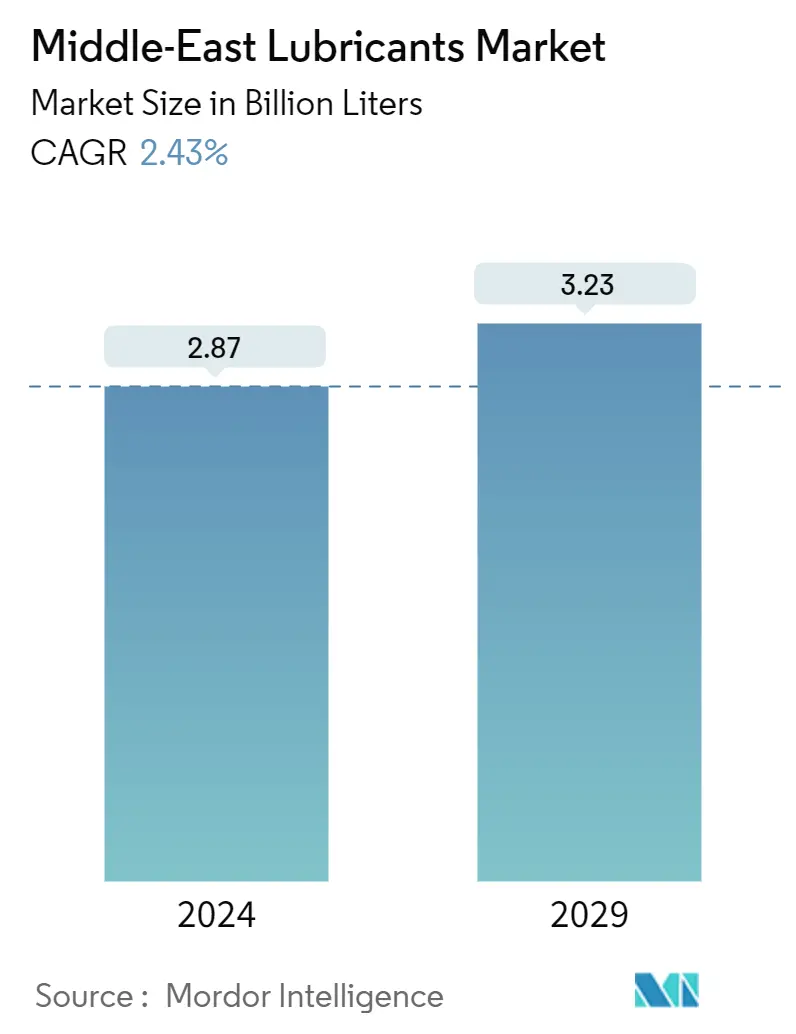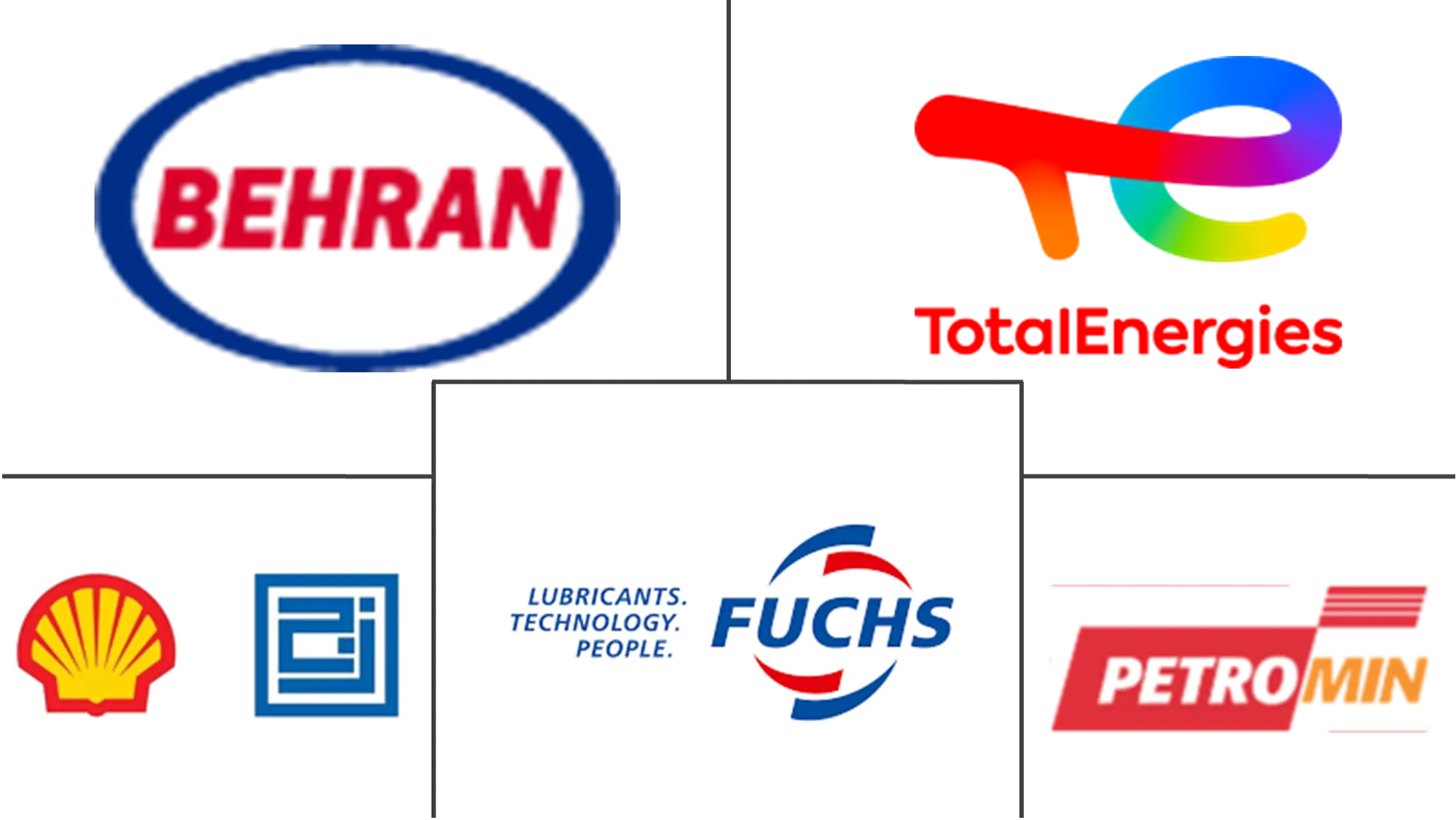Market Size of Middle-East Lubricants Industry

| Study Period | 2019 - 2029 |
| Base Year For Estimation | 2023 |
| Market Volume (2024) | 2.87 Billion liters |
| Market Volume (2029) | 3.23 Billion liters |
| CAGR (2024 - 2029) | 2.43 % |
| Market Concentration | Medium |
Major Players
*Disclaimer: Major Players sorted in no particular order |
Middle East Lubricants Market Analysis
The Middle-East Lubricants Market size is estimated at 2.87 Billion liters in 2024, and is expected to reach 3.23 Billion liters by 2029, growing at a CAGR of 2.43% during the forecast period (2024-2029).
Due to the COVID-19 outbreak, the manufacturing industry was severely affected, and this resulted in a decrease in the use of lubricants in 2020. However, with the recovery of many construction projects and other industrial activities, the market saw a recovery phase in the year 2021. It is expected to see a positive trend in the forecasted years. An increase in automotive sales and engineering goods has been leading the market recovery over the last two years.
The industrial growth in Saudi Arabia, Iran, and the United Arab Emirates and the growing usage of high-performance lubricants are the major driving factors augmenting the growth of the market studied.
On the flip side, costlier high-performance lubricants are expected to hinder the growth of the market.
Developments in synthetic and bio-based lubricants are projected to act as an opportunity for the market in the future.
Saudi Arabia emerged as the largest market for lubricants and is expected to register the highest CAGR during the forecast period.
Middle East Lubricants Industry Segmentation
A lubricant is a substance that helps to reduce friction between surfaces in mutual contact, which ultimately reduces the heat generated when the surfaces move. It may also have the function of transmitting forces, transporting foreign particles, or heating or cooling the surfaces.
The Middle East lubricants market is segmented by group, base stock, product type, end-user industry, and geography. By group, the market is segmented into group I, group II, group III, group IV (PAO), and naphthenic. By base stock, the market is segmented into bio-based lubricants, mineral oil lubricants, synthetic lubricants, and semi-synthetic lubricants. By product type, the market is segmented into engine oil, transmission and hydraulic fluid, metalworking fluid, general industrial oil, gear oil, greases, process oil, and other product types (turbine oils, refrigeration oils, aviation oils, marine oils, and transformer oils). By end-user industry, the market is segmented into power generation, automotive and other transportation, heavy equipment, food and beverage, metallurgy and metalworking, chemical manufacturing, and other end-user industries (marine, textiles, manufacturing, and oil and gas). The report also covers the market size and forecasts for the lubricant market in 5 countries across the Middle East.
For each segment, the market sizing and forecasts have been done based on volume (liters).
| Group | |
| Group I | |
| Group II | |
| Group III | |
| Group IV (PAO) | |
| Naphthenics |
| Base Stock | |
| Bio-based Lubricant | |
| Mineral Oil Lubricant | |
| Synthetic Lubricant | |
| Semi-synthetic Lubricant |
| Product Type | |
| Engine Oil | |
| Transmission and Hydraulic Fluid | |
| Metalworking Fluid | |
| General Industrial Oil | |
| Gear Oil | |
| Greases | |
| Process oils | |
| Other Product Types (Turbine oils, Refrigeration oils, Aviation oils, Marine oils, and Transformer oils) |
| End-user Industry | |
| Power Generation | |
| Automotive and Other Transportation | |
| Heavy Equipment | |
| Food and Beverage | |
| Metallurgy and Metalworking | |
| Chemical Manufacturing | |
| Other End-user Industries (Marine, Textiles, Manufacturing, and Oil and gas) |
| Geography | |
| Saudi Arabia | |
| Iran | |
| Iraq | |
| United Arab Emirates | |
| Kuwait | |
| Rest of Middle-East |
Middle-East Lubricants Market Size Summary
The Middle East lubricants market is poised for growth, driven by the recovery of industrial activities and increased automotive sales in the region. The market, which experienced a downturn due to the COVID-19 pandemic, has rebounded with the resurgence of construction projects and industrial operations. Key players in the market include Saudi Arabia, Iran, and the United Arab Emirates, with Saudi Arabia emerging as the largest market. The demand for high-performance lubricants is on the rise, supported by the growing automotive sector and advancements in synthetic and bio-based lubricants. However, the high cost of these lubricants poses a challenge to market expansion. The automotive industry, particularly in Saudi Arabia, remains a significant contributor to the market, with internal combustion engine vehicles expected to dominate for the foreseeable future despite the global shift towards electric vehicles.
The market landscape is characterized by a diverse range of applications, including wear reduction and corrosion protection, essential for the smooth operation of engines. The increasing average age of vehicles and the expanding urban population in developing countries present opportunities for the aftermarket refill market. The United Arab Emirates and Iran are also witnessing growth in vehicle registrations and production, further bolstering the demand for lubricants. Saudi Arabia's economic diversification efforts, particularly in the energy and metal industries, alongside significant investments in power and renewable energy projects, are expected to drive the lubricants market. The fragmented market features major companies like TotalEnergies, Petromin, and Shell Lubricating Oil Company, which continue to innovate and expand their product offerings to meet the evolving needs of the region.
Middle-East Lubricants Market Size - Table of Contents
-
1. MARKET DYNAMICS
-
1.1 Drivers
-
1.1.1 Industrial Growth in Saudi Arabia, Iran, and the United Arab Emirates
-
1.1.2 Growing Usage of High-performance Lubricants
-
1.1.3 Other Drivers
-
-
1.2 Restraints
-
1.2.1 Costlier High Performance Lubricants
-
1.2.2 Other Restraints
-
-
1.3 Industry Value Chain Analysis
-
1.4 Porter's Five Forces Analysis
-
1.4.1 Bargaining Power of Suppliers
-
1.4.2 Bargaining Power of Buyers
-
1.4.3 Threat of New Entrants
-
1.4.4 Threat of Substitute Products and Services
-
1.4.5 Degree of Competition
-
-
1.5 Regulatory Policy Analysis
-
-
2. MARKET SEGMENTATION (Market Size in Volume)
-
2.1 Group
-
2.1.1 Group I
-
2.1.2 Group II
-
2.1.3 Group III
-
2.1.4 Group IV (PAO)
-
2.1.5 Naphthenics
-
-
2.2 Base Stock
-
2.2.1 Bio-based Lubricant
-
2.2.2 Mineral Oil Lubricant
-
2.2.3 Synthetic Lubricant
-
2.2.4 Semi-synthetic Lubricant
-
-
2.3 Product Type
-
2.3.1 Engine Oil
-
2.3.2 Transmission and Hydraulic Fluid
-
2.3.3 Metalworking Fluid
-
2.3.4 General Industrial Oil
-
2.3.5 Gear Oil
-
2.3.6 Greases
-
2.3.7 Process oils
-
2.3.8 Other Product Types (Turbine oils, Refrigeration oils, Aviation oils, Marine oils, and Transformer oils)
-
-
2.4 End-user Industry
-
2.4.1 Power Generation
-
2.4.2 Automotive and Other Transportation
-
2.4.3 Heavy Equipment
-
2.4.4 Food and Beverage
-
2.4.5 Metallurgy and Metalworking
-
2.4.6 Chemical Manufacturing
-
2.4.7 Other End-user Industries (Marine, Textiles, Manufacturing, and Oil and gas)
-
-
2.5 Geography
-
2.5.1 Saudi Arabia
-
2.5.2 Iran
-
2.5.3 Iraq
-
2.5.4 United Arab Emirates
-
2.5.5 Kuwait
-
2.5.6 Rest of Middle-East
-
-
Middle-East Lubricants Market Size FAQs
How big is the Middle-East Lubricants Market?
The Middle-East Lubricants Market size is expected to reach 2.87 billion liters in 2024 and grow at a CAGR of 2.43% to reach 3.23 billion liters by 2029.
What is the current Middle-East Lubricants Market size?
In 2024, the Middle-East Lubricants Market size is expected to reach 2.87 billion liters.

